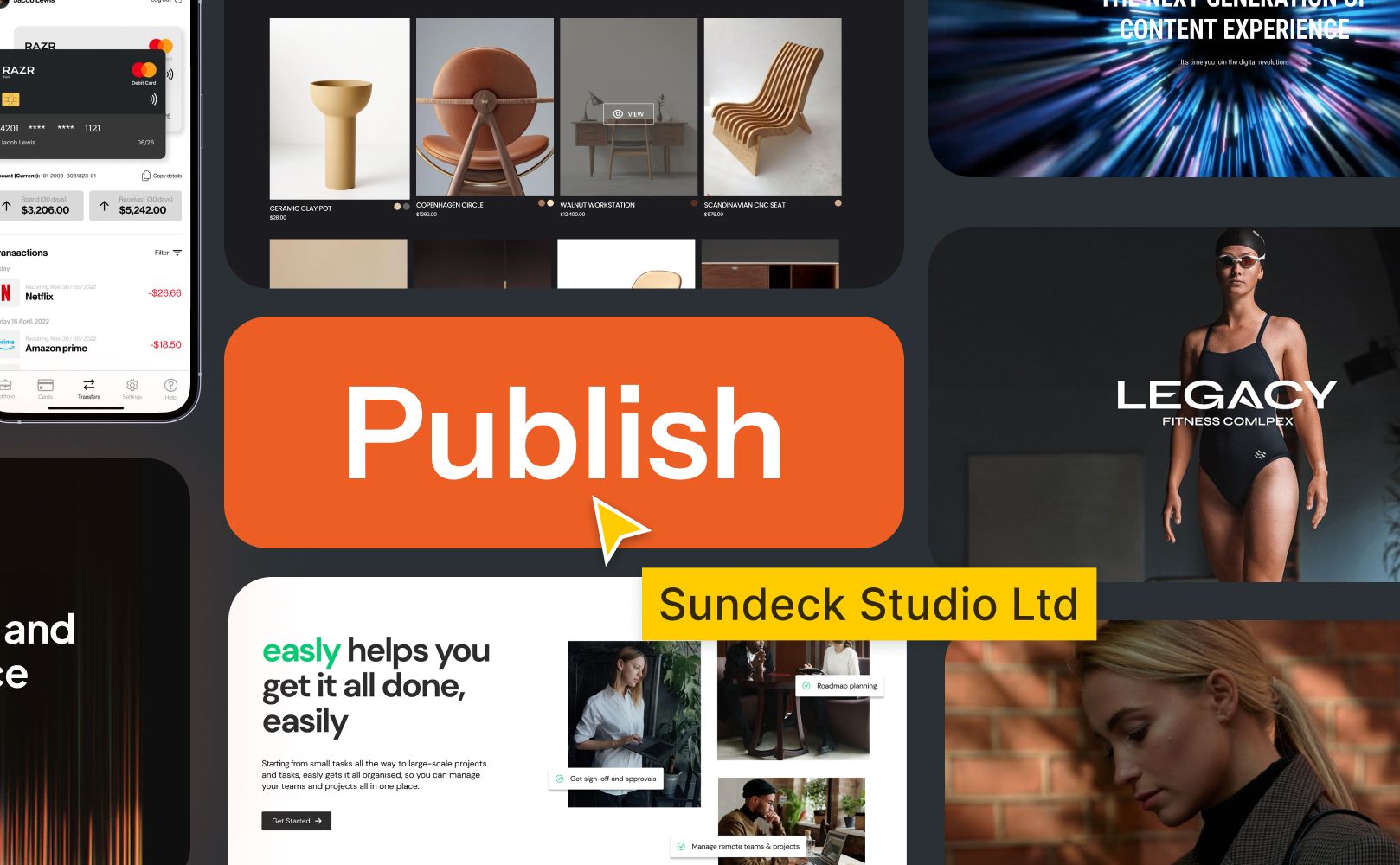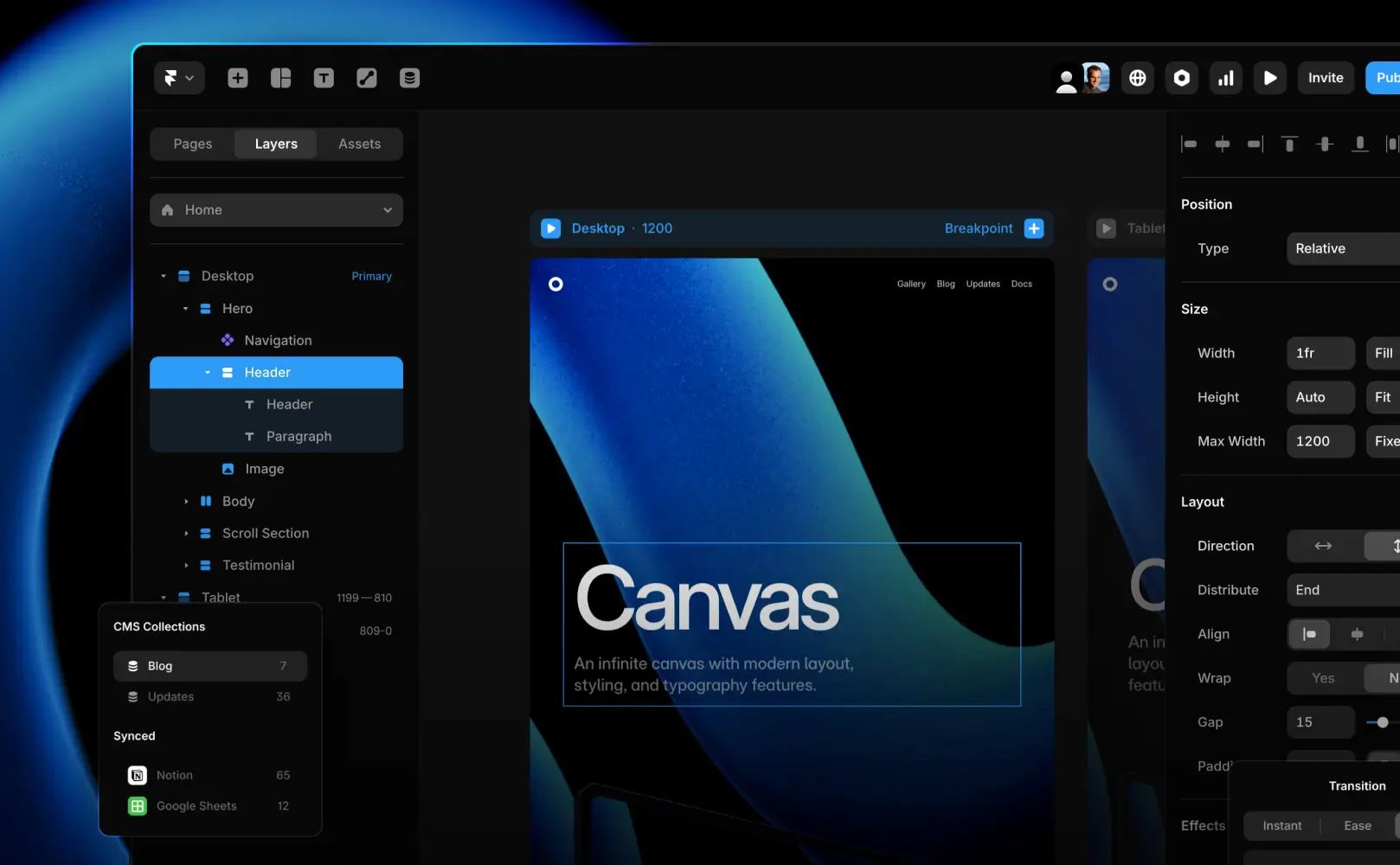
The day is here, one of the most popular, widely used and easiest to use design app, Figma has finally launched their own web page building and hosting suite. Figma’s own website builder called Figma Sites represents a powerful convergence of design and development capabilities, offering web designers, marketing agencies, small businesses and no-code website builders, a comprehensive solution that might just make platforms like WebFlow & Framer obsolete. If this dethrones Webflow, it might also start to sundeck the some Webflow development agencies.
The current low-code web development process
So far the workflow for many no-code web creators and web designers has been that they’ll design in Figma, then migrate those designs using Webflow or Framer plugins into Webflow / Framer environment. Some creators used tools like Relume, to use prebuilt Figma templates that are compatible with Webflow or Framer building style.
Figma sites replaces this need of migration, plugins or tools, by keeping your design to web publishing within the Figma eco-system. It just makes more sense, less admin, less platforms to manage and hopefully, less licenses.
What exactly is Figma sites?
Figma Sites enables designers and developers to design, prototype, and publish high-quality websites, all within a single environment, without writing a line of code, almost.
This unified approach eliminates the fragmentation that has long plagued the web creation process, allowing teams to move seamlessly from concept to live site without switching between multiple tools.
The platform delivers several key capabilities, while staying within the Figma ecosystem:
- Responsive layouts that automatically adapt to any screen size
- Familiar design tools from Figma Design, including frames, auto layout, and components
- Seamless copy-paste functionality between Figma Design and Figma Sites
- Rich interactions and animations including marquee scrolling, custom cursors, and hover effects
- Instant sharing of live websites for collaboration, usability testing, and iteration
- And soon CMS capabilities
How to use Figma sites: The user interface
Figma Sites features a thoughtfully designed interface that prioritizes workflow efficiency. The left navigation bar provides quick access to essential functions:
- File View: The central workspace for building webpages with a comprehensive layer management system
- Insert Panel: Access to prebuilt Elements, Figma templates, Embeds and Design libraries
- Search: Quickly locate specific elements within complex designs
- Make Panel: Upcoming code layer functionality for enhanced creative control
- CMS Panel: Soon-to-be-released content management capabilities. This will help users make blogs, portfolios or any site-type that requires CMS
- Settings: Configuration options for SEO, accessibility, and user experience optimisation
The toolbar contains all necessary creation tools, while the right sidebar offers contextual controls for styling and interactivity through dedicated Design and Interactions tabs.
From Design to Development without friction of licenses, seats and migration
Figma’s built-in website builder dramatically reduces the traditional barriers between design and development. Designers can copy and paste directly from Figma Design into webpages or access existing design libraries, maintaining perfect fidelity throughout the process.
For those starting fresh, the platform offers a robust library of pre-built blocks—including landing pages, headers, footers, and customisable sections, that can be quickly assembled into complete working fully developed websites, making it one of the most robust and best website builders.
All features included in Figma Sites
Prompt to code functionality using natural language prompts (via Make)
Figma Make represents a breakthrough in the design-to-code workflow. This is different to those AI web page builders, it allows creators to generate code through natural language prompts, enabling rapid exploration and refinement of interactive elements.
The system preserves design system integrity and component hierarchy while adding interactive behaviors, a significant advantage over other web development tools and website builders that often compromise design fidelity when translating to functional code.
The only worry here is the name copyright as there’s already an existing tool called “Make” used for automation, similar to Zapier, widely used for CRM and marketing automations.
Responsive by default
Unlike many platforms that struggle with responsive implementation, Figma Sites automatically adapts layouts, text, and designs across different breakpoints. The multi-edit capability allows creators to make changes across screen sizes simultaneously, while text styles can be configured for specific breakpoints without complex variable systems.
This approach ensures designs translate seamlessly to any device while still providing manual adjustment options for precision control. This is very similar to what we have seen with Framer’s responsive capabilities. Webflow? Not so much.
Interactions & animations
Figma Sites introduces interaction capabilities that surpass even those available in Figma Design:
- Scroll parallax and scroll transform effects
- Hover and pressed states without requiring interactive components
- Marquee animations for dynamic horizontal content presentation
- Reveal effects for polished scrolling experiences
The upcoming code layers feature will further extend these capabilities, allowing designers to transform static designs into rich interactive experiences without relying on external tools or plugins.
Integrated design system support
The platform allows teams to link published component libraries directly into sites through the inserts panel, ensuring design consistency and accelerating development. For those without established design systems, Figma Sites provides commonly used blocks and templates as starting points.
Seamless Publishing & Hosting built-in hosting infrastructure
Figma Sites includes integrated hosting capabilities that streamline the publishing process. Users can preview sites to experience animations, interactions, and responsive behaviours before making them live. When ready, sites can be published with a few clicks and optionally connected to custom domains (available on all paid plans).
This unified approach eliminates the need for separate web hosting arrangements or complex deployment procedures, CDN, security procedures, as it will all be taken care of by Figma.
CMS Integration (coming soon)
One of the most anticipated features for Figma Sites is its upcoming built-in CMS functionality. This addition will significantly enhance the platform's capabilities for content-heavy websites like portfolios, blogs, or any site requiring large data sets with consistent layouts.
While pricing details for this feature remain unknown, industry observers note that if Figma includes CMS functionality in its standard pricing (unlike WebFlow, which charges extra), it could trigger a significant migration of users from competing platforms.
Watch Figma CMS sneak peek here
Figma Sites pricing plans
Enterprise and Organization: Figma sites allows unlimited custom domains for Enterprise and Organization plans
Professional plans: get 10 custom domains. With no limit on bandwidth or storage until 2026
Education & student plans: The sites feature has not rolled out yet, no news if it will be available for Education or Student plans.
According to Figma: Limits subject to change after 2025.
Will Figma Sites replace WebFlow, Framer and many other small-scale cloud-based page builders?
Figma Sites represents a comprehensive rethinking of the web creation workflow. By combining familiar design tools with powerful development capabilities, integrated hosting, and soon-to-be-released CMS functionality, all within a single environment, Figma has created an offering that directly challenges specialized platforms like WebFlow and Framer.
As Figma Sites continues to mature and expand its capabilities, WebFlow and Framer may find themselves facing an increasingly difficult battle to maintain their market positions against this powerful all-in-one competitor. Especially considering that Figma already has a well-built ecosystem and user-base of designers and organisations.
Who is Figma sites for? The ideal target audience
Figma sites ticks off alot of use case boxes but the primary audience that may benefit from it are :
- UI designers who are already familiar with Figma but do not have web development or no-code builder expertise, can now work in familiar Figma UI and host their own sites
- Small business owners who have in-house Figma designers and need a quick, small business website without hiring a Webflow developer or web developer.
- Design system creators who want to publish their paid design systems can now package it with a fully hosted website
- Low-code developers who were forced to work between multiple licenses, plugins will not have to go to another page builder anymore and can host websites within Figma.
How can UI designers & Web designers use Figma Sites
- Figma sites (along with CMS capabilities) will help web designers build their portfolio sites without leaving Figma
- For small sites, you can ship a completely hosted website instead of just the UI design
- Easier collaboration with developers by using Make for interaction design, and a design system that easily translates into a working website
- Responsive resolved. With Figma sites, since it easily adapts to responsive breakpoints, it will become easier for UI designers to present resposnive designs without having to design multiple screens manually
How can small business websites use Figma Sites
Small business website design and development can benefit from Figma sites. If you have an existing design, without having to hire a web developer for a small site, you can directly publish existing designs to a fully working website
What does this mean for Webflow developers
Game over! Kidding.
Webflow developers might be better off adding a new set of skills to their profile. However webflow and framer do offer some distinctive features. Webflow has recently launched Webflow cloud, which offers server functions on the front-end, enabling more dynamic sites. Using those as an advantage over Figma sites can be helpful. However, in longer game, instead of being tied to a platform it's ideal to be sell your services as a comprehensive solution.
Figma sites may not fully replace (yet) Webflow or Framer, but it defenitely will add a healthier competition in the market. For smaller, quick sites, for now it might become a more feasible option. In future if Figma adds capability to add more dynamic features (along with CMS) it will start to add more competition even for larger page builders. Competition is good, but if web developers, or web design agencies are platform-agnostic, they'll see a hard time to repeatedly sell the same platform. Instead focus on selling the outcome and benefit you bring to the client / business.
This is why our team at Sundeck studio doesn't limit ourself to one platform (be it WordPress, Webflow, or anything), instead we understand the business requirement, website's feature and requirement and offer a more long-term approach that can scale as the business grow, without adding unnecessary platform complexity.








